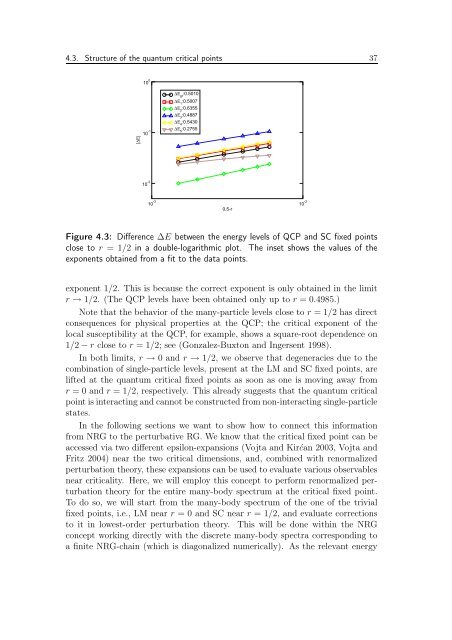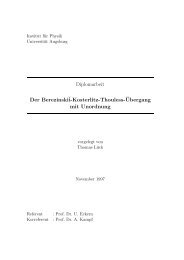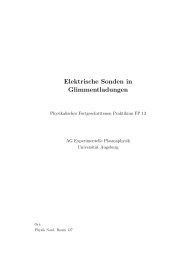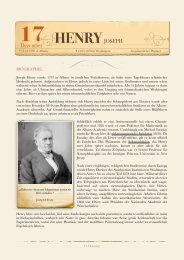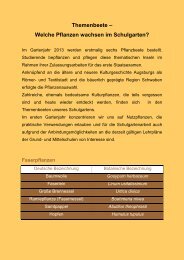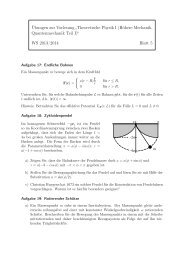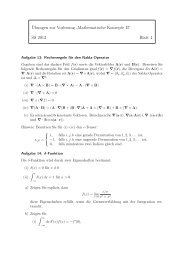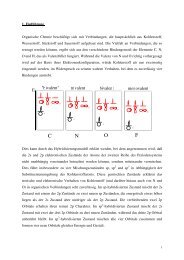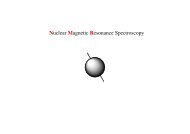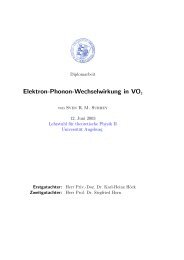Numerical Renormalization Group Calculations for Impurity ...
Numerical Renormalization Group Calculations for Impurity ...
Numerical Renormalization Group Calculations for Impurity ...
Create successful ePaper yourself
Turn your PDF publications into a flip-book with our unique Google optimized e-Paper software.
4.3. Structure of the quantum critical points 37<br />
10 0<br />
|∆Ε|<br />
10 -1<br />
∆Ε gr :0.5010<br />
∆Ε 1 :0.5007<br />
∆Ε 2 :0.6355<br />
∆Ε 3<br />
:0.4887<br />
∆Ε 4 :0.5430<br />
∆Ε 5 :0.2755<br />
10 -2<br />
10 -3 10 -2<br />
0.5-r<br />
Figure 4.3: Difference ∆E between the energy levels of QCP and SC fixed points<br />
close to r = 1/2 in a double-logarithmic plot. The inset shows the values of the<br />
exponents obtained from a fit to the data points.<br />
exponent 1/2. This is because the correct exponent is only obtained in the limit<br />
r → 1/2. (The QCP levels have been obtained only up to r = 0.4985.)<br />
Note that the behavior of the many-particle levels close to r = 1/2 has direct<br />
consequences <strong>for</strong> physical properties at the QCP; the critical exponent of the<br />
local susceptibility at the QCP, <strong>for</strong> example, shows a square-root dependence on<br />
1/2 − r close to r = 1/2; see (Gonzalez-Buxton and Ingersent 1998).<br />
In both limits, r → 0 and r → 1/2, we observe that degeneracies due to the<br />
combination of single-particle levels, present at the LM and SC fixed points, are<br />
lifted at the quantum critical fixed points as soon as one is moving away from<br />
r = 0 and r = 1/2, respectively. This already suggests that the quantum critical<br />
point is interacting and cannot be constructed from non-interacting single-particle<br />
states.<br />
In the following sections we want to show how to connect this in<strong>for</strong>mation<br />
from NRG to the perturbative RG. We know that the critical fixed point can be<br />
accessed via two different epsilon-expansions (Vojta and Kirćan 2003, Vojta and<br />
Fritz 2004) near the two critical dimensions, and, combined with renormalized<br />
perturbation theory, these expansions can be used to evaluate various observables<br />
near criticality. Here, we will employ this concept to per<strong>for</strong>m renormalized perturbation<br />
theory <strong>for</strong> the entire many-body spectrum at the critical fixed point.<br />
To do so, we will start from the many-body spectrum of the one of the trivial<br />
fixed points, i.e., LM near r = 0 and SC near r = 1/2, and evaluate corrections<br />
to it in lowest-order perturbation theory. This will be done within the NRG<br />
concept working directly with the discrete many-body spectra corresponding to<br />
a finite NRG-chain (which is diagonalized numerically). As the relevant energy


